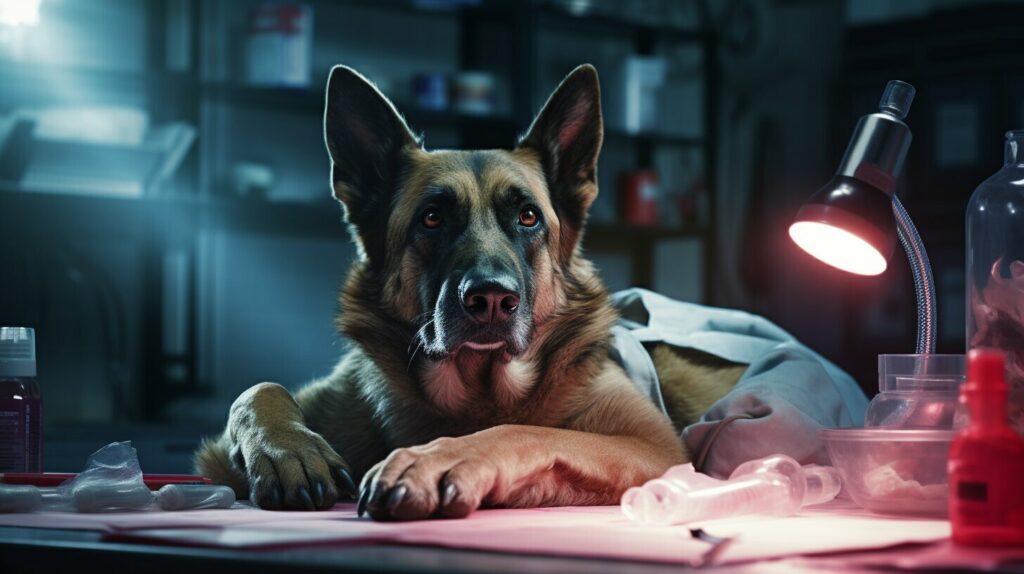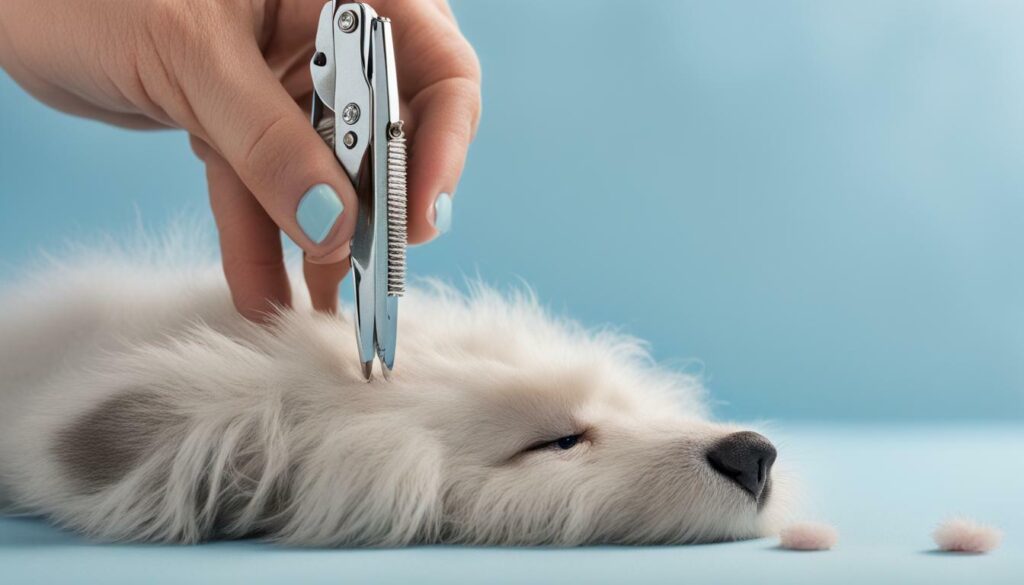If you’re a dog owner, you understand the importance of keeping your furry friend healthy and happy. And when it comes to taking care of your dog’s injuries and wounds, you want to make sure you’re doing everything you can to promote healing and prevent infections. One common tool in many pet owners’ first aid kits is Neosporin, an over-the-counter antiseptic ointment used for human cuts and scrapes. But is Neosporin safe for dogs? Let’s explore the facts.
Key Takeaways:
- Neosporin is a popular antiseptic ointment used for human wounds.
- As a dog owner, you want to ensure proper wound care and prevent infections.
- Before using Neosporin on your dog, it’s important to understand its potential risks and benefits.
- Consulting a veterinarian for guidance on dog wound care is always recommended.
Understanding Dog Wound Care
As a responsible dog owner, it’s important to know how to properly care for your furry friend’s wounds. Here are some essential tips on dog wound care:
- Prompt Attention: It’s important to address any cuts or wounds immediately. Waiting too long can lead to infection and other complications. Inspect your dog’s skin regularly, especially after outdoor activities or playing.
- Cleanliness: Keeping the wound clean is crucial. Use lukewarm water and mild soap to clean the affected area, and gently pat it dry with a clean towel. Avoid using alcohol or hydrogen peroxide, as they can damage the healthy tissues, delay wound healing, and cause pain and discomfort.
- Promoting Healing: Promoting proper healing is equally important. Make sure your dog gets enough rest, and provide them with a healthy diet that’s rich in high-quality proteins, vitamins, and minerals.
Aside from these general tips, here are some important wound care tips that you need to keep in mind:
- Regularly monitor the wound for signs of infection, such as redness, swelling, pus, or foul odor.
- Prevent your dog from licking or scratching the wound.
- Keep the wound dry and avoid any activities that might irritate it, such as excessive exercise or exposure to extreme temperatures.
- If the wound appears to be deep or shows no signs of healing within a few days, then you should consult a veterinarian immediately.
By following these tips, you can ensure that your dog’s wound heals properly and doesn’t develop any complications.
Neosporin for Dog’s Cuts: The Benefits and Risks
When your dog gets a cut, you want to ensure it heals quickly and without complications. That’s where Neosporin comes in – it’s an over-the-counter antibiotic ointment that can potentially help reduce the risk of infection and promote healing.
However, it’s important to consider both the benefits and risks of using Neosporin on your dog’s cuts. Neosporin may be suitable for minor wounds, but for more severe injuries, it may not be enough.
It’s crucial to keep in mind that while Neosporin may be beneficial, it’s not a substitute for proper wound care. You’ll still need to clean the wound thoroughly and monitor it closely to watch for signs of infection.
Benefits of Neosporin for Dog Wound Healing
When used correctly, Neosporin can be useful in promoting healing and reducing the risk of infection, along with other potential benefits. Some of these benefits include:
- Protection against bacteria: Neosporin contains an antibiotic that can destroy harmful bacteria that may cause an infection.
- Reducing inflammation: The ointment can help minimize inflammation and redness around the wound.
- Pain relief: It may also help alleviate pain caused by the wound.
Risks of Using Neosporin on Dogs
While Neosporin can be beneficial, it’s important to be aware of the potential risks associated with its use. Some of these risks include:
- Allergic reactions: Some dogs may be allergic to Neosporin, leading to symptoms such as skin irritation or difficulty breathing.
- Toxicity concerns: If your dog ingests Neosporin, it can be toxic and lead to serious side effects such as vomiting and diarrhea.
- Antibiotic resistance: Overuse of antibiotics may cause bacterial resistance, which can make it harder to treat infections in the future.
Ultimately, the decision to use Neosporin on your dog’s wound depends on the severity and location of the cut, along with the potential risks and benefits. If you’re unsure whether Neosporin is the right choice, consult with your veterinarian, who can provide guidance on proper wound care and recommend alternative treatments if necessary.
Safe Alternatives to Neosporin for Dogs
If you prefer to avoid using Neosporin on your dog’s skin or are looking for alternative options for wound care, there are several safe and effective alternatives available. Before choosing any treatment, however, it is advisable to consult a veterinarian to ensure the best possible care for your dog’s specific needs.
Natural Remedies
Some natural remedies can be used for minor skin irritations, scrapes, and injuries. These remedies include:
- Coconut oil: has antimicrobial properties and can soothe irritated skin when applied topically.
- Raw honey: can be used as a natural wound dressing and has antibacterial properties.
- Aloe vera: a natural anti-inflammatory agent that can promote healing and soothe irritated skin.
It is important to note that some natural remedies may not be appropriate for certain dog breeds or medical conditions.
Veterinary-Recommended Alternatives
Veterinarians may recommend alternative treatments for wound care, such as:
- Betadine solution: an antiseptic solution that can be used to clean wounds and prevent infection.
- Silver sulfadiazine: a topical cream that can help prevent infection and promote healing in deeper cuts or burns.
- Chlorhexidine: a disinfectant that can be used for skin and wound infections.
It is important to follow veterinary instructions when using any alternative treatments.
When to Consult a Veterinarian
If your dog has a severe wound or injury, it is important to seek veterinary attention immediately. Additionally, if your dog’s wound is not healing or is showing signs of infection, it is advisable to consult a veterinarian for guidance. In some cases, a course of antibiotics may be necessary to treat an infection.
Remember, proper wound care is crucial for your dog’s overall health and well-being. By following veterinary advice and exploring safe alternatives, you can help ensure your dog receives the best possible care.
Determining the Need for Neosporin on Dogs
As a responsible dog owner, your pet’s health and safety are a top priority. When it comes to treating your dog’s wounds, it’s important to determine whether Neosporin is necessary.
If your dog has a minor cut or scrape, Neosporin can be an effective antiseptic to prevent infection and promote healing. However, if the wound is more severe or accompanied by excessive bleeding or signs of infection such as redness, swelling, or discharge, it’s important to seek veterinary attention. Your veterinarian may recommend alternative treatments or antibiotics if necessary.
It’s also important to consider your dog’s individual health and any existing medical conditions. For example, dogs with allergies or sensitive skin may have adverse reactions to Neosporin or other topical ointments. Always consult with your veterinarian before using any new products on your dog’s skin.
When in doubt, always err on the side of caution and seek veterinary guidance for proper wound care. Your veterinarian can provide personalized recommendations and advice specific to your dog’s needs.
Application and Usage Guidelines for Neosporin on Dogs
When using Neosporin on your dog, it’s important to follow proper application and usage guidelines to ensure safe and effective treatment of cuts and wounds. Here are some steps to follow:
- Clean the wound: Before applying Neosporin, clean the wound thoroughly with sterile saline solution or warm water and mild soap. Pat dry with a clean towel or gauze.
- Apply Neosporin: Apply a thin layer of Neosporin on the wound, covering the entire affected area. Be sure to use a clean cotton swab or gauze pad to avoid introducing more bacteria to the wound.
- Cover the wound: Depending on the size and location of the wound, you may need to cover it with a sterile bandage to keep it clean and promote healing. Change the bandage regularly as directed by your veterinarian.
- Monitor the wound: Keep an eye on the wound and the surrounding area for any signs of infection, such as redness, swelling, or discharge. If you notice any of these symptoms, consult your veterinarian.
- Follow dosage instructions: Be sure to follow the recommended dosage instructions for Neosporin as directed by your veterinarian. Overuse of the medication can lead to toxicity and other adverse effects.
- Consult with your veterinarian: Always consult with your veterinarian before using Neosporin or any other medication on your dog’s wounds. Your veterinarian can provide personalized guidance on dosing, application, and any potential risks or interactions with other medications or health conditions.
Remember, Neosporin should only be used on minor cuts and wounds and is not a substitute for proper veterinary care. If your dog has a severe, deep, or infected wound, or if you are unsure whether to use Neosporin or seek veterinary attention, consult with your veterinarian for guidance.
Monitoring and Evaluating the Effects of Neosporin on Dogs
After applying Neosporin to your dog’s cuts or wounds, it is important to monitor and evaluate its effects regularly. Here are some things you should look for:
- Improved wound healing: Neosporin is known to promote wound healing by preventing infections. You should observe your dog’s wound and look for signs of improvement, such as reduced redness, swelling, and discharge.
- Adverse reactions: Although Neosporin is generally safe for dogs, some may develop allergic reactions to its ingredients. Watch for signs of an adverse reaction, such as excessive itching, swelling, or irritation. If you notice any of these symptoms, stop using Neosporin immediately and consult your veterinarian.
- Duration of use: Neosporin should only be used for a short period of time, usually up to one week. If your dog’s wound does not show signs of healing within this time frame, you should seek veterinary attention as soon as possible.
Remember that Neosporin is not a cure-all for every type of wound or cut your dog may have. If you are unsure about using Neosporin for your dog’s specific injury, it is always best to consult with your veterinarian first.
Risks and Side Effects of Neosporin on Dogs
While Neosporin can be beneficial for treating wounds in dogs, it is important to be aware of the potential risks and side effects.
One of the primary concerns is the risk of an allergic reaction. Some dogs may be sensitive to Neosporin, which can result in symptoms such as itching, swelling, and difficulty breathing. In severe cases, an allergic reaction can be life-threatening and require immediate veterinary attention.
Another potential risk is the toxicity of certain ingredients in Neosporin, particularly if ingested. This can cause vomiting, diarrhea, and other gastrointestinal issues. It is essential to keep Neosporin out of reach of your dogs and only use the recommended dosage.
Additionally, while Neosporin is an antiseptic, it is not without its limitations. It may not be effective against certain types of bacteria, and overuse can lead to antibiotic resistance.
Consulting with a veterinarian is crucial to determine whether Neosporin is the best treatment option for your dog’s wound. Your vet may recommend alternative antiseptics or prescribe antibiotics if necessary.
In general, using Neosporin for dog wound care should be approached with caution and only under veterinary guidance. Proper wound care, including cleaning and monitoring, is critical in promoting healing and preventing infection.
Consulting a Veterinarian for Dog Wound Care
While home remedies and over-the-counter products like Neosporin can be helpful for minor cuts and wounds in your dog, it’s always best to consult with a veterinarian for proper wound care and treatment.
Your veterinarian can provide guidance and advice on the best course of action for your dog’s specific wound, including whether or not Neosporin is the best option. They can also prescribe stronger medications or recommend specialized treatments for more severe wounds.
In addition, if you notice any concerning symptoms or reactions to Neosporin or any other treatment, it’s crucial to contact your veterinarian immediately. Symptoms may include redness, swelling, discharge, or persistent pain.
Remember that maintaining proper wound care and seeking professional help when needed can help your dog heal more quickly and prevent further complications or infections.
Natural Remedies for Dog Wound Care
When it comes to caring for your dog’s wounds or scrapes, natural remedies can be an effective alternative to Neosporin. Not only are they often safer and gentler for your pet, but they can also be more cost-effective and readily available.
Here are a few natural remedies you can try for your dog’s wound care:
- Apple Cider Vinegar: This natural antiseptic can help clean and disinfect wounds. Dilute it with water and apply it to the affected area using a clean cloth or cotton ball.
- Coconut Oil: This oil has antibacterial and anti-inflammatory properties, making it a great natural remedy for minor cuts and scrapes. Simply apply it directly to the wound.
- Calendula: This herb has antifungal and anti-inflammatory properties and can help promote wound healing. Make a tea from the flowers and apply it to the wound using a clean cloth.
- Aloe Vera: The gel from this plant can help soothe and heal minor cuts and scrapes. Apply it directly to the wound.
Remember to always consult with your veterinarian before trying any new treatments or remedies.
If your dog’s wound is severe or does not seem to be healing properly, it is important to seek professional veterinary care.
Using natural remedies for dog wound care can be a safe and effective alternative to Neosporin. Not only can they help clean and heal wounds, but they can also provide peace of mind knowing you are using gentle, natural ingredients on your furry friend.
Evaluating Neosporin Use in Specific Dog Breeds
While Neosporin is generally considered safe for most dogs, certain breeds may have different reactions due to their specific genetic makeup or health conditions. It is important to take these factors into consideration when deciding whether to use Neosporin on your dog’s wounds.
For example, breeds with thin skin and hair, such as Greyhounds and Whippets, may be more sensitive to topical medications like Neosporin. Brachycephalic breeds, such as Bulldogs and Pugs, may have respiratory issues that could be aggravated by Neosporin’s fumes.
Additionally, dogs with pre-existing medical conditions, such as allergies or autoimmune disorders, may have adverse reactions to Neosporin or other antiseptics. It’s essential to consult with your veterinarian before using any medication or treatment on your dog.
If you are unsure whether your dog’s breed or health condition may be affected by Neosporin or other treatments, consult with your veterinarian for guidance on proper wound care.
Conclusion
After exploring the facts and considerations surrounding the use of Neosporin on dogs, it is clear that it can be a useful tool in promoting healing and preventing infections in cuts and wounds. However, it is important to use it responsibly and in conjunction with appropriate wound care practices.
Remember that Neosporin should never be used on deep or severe wounds without veterinary guidance, and should only be used externally on the skin. Additionally, it is essential to monitor for any adverse reactions or allergies and discontinue use if necessary.
While Neosporin can be a helpful tool for dog wound care, there are also many natural remedies and veterinary-recommended alternatives that can be effective. It is important to consult a veterinarian for guidance on which treatment option is most suitable for your dog’s needs.
Overall, ensuring proper dog wound care is paramount in promoting healing and preventing complications. Take the time to clean and care for your dog’s wounds promptly, and always seek veterinary attention for any severe or concerning injuries.
By taking these steps and using Neosporin responsibly, you can help your furry friend stay healthy and happy.
FAQ
Q: Is Neosporin safe for dogs?
A: Neosporin can be safe for dogs when used properly, but it is important to consult with a veterinarian before administrating any medication to your dog.
Q: Can I use Neosporin on my dog’s cuts?
A: Neosporin can be used on dog cuts, but it is important to follow veterinary advice and ensure cleanliness during application.
Q: Are there any risks or side effects of using Neosporin on dogs?
A: There can be risks and side effects associated with using Neosporin on dogs, including allergic reactions and toxicity concerns. It is important to use appropriate dosage and consult a veterinarian if any adverse reactions occur.
Q: Are there safe alternatives to Neosporin for dogs?
A: Yes, there are safe alternatives to Neosporin for various skin issues in dogs. Natural remedies and veterinary-recommended alternatives can be used in certain cases.
Q: When should I consult a veterinarian for dog wound care?
A: It is advisable to consult a veterinarian for dog wound care, especially for more severe wounds or specialized treatments. A veterinarian can provide specific guidance based on your dog’s condition.
Q: Are there natural remedies for dog wound care?
A: Yes, there are natural remedies and home treatments that can be used for dog wound care, such as natural antiseptics and herbal solutions.
Q: Should I monitor the effects of Neosporin on my dog’s wounds?
A: Yes, it is important to monitor the effects of Neosporin on your dog’s wounds. Look for signs of improvement and potential adverse reactions. If any concerns arise, consult a veterinarian.
Q: Can Neosporin be used on specific dog breeds?
A: Neosporin can be used on specific dog breeds, but there may be breed-specific sensitivities or interactions with breed-specific health conditions. Consult a veterinarian for guidance.



